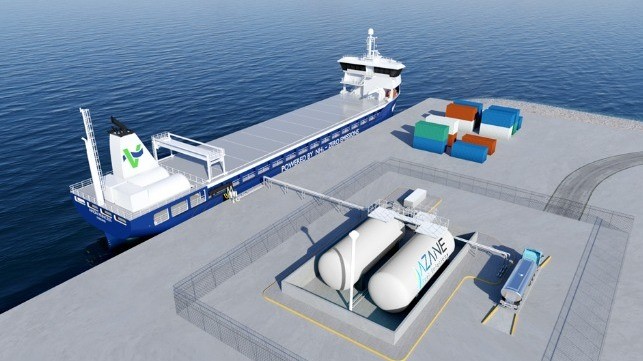While extensive research efforts are underway to develop the propulsion systems for ships that will use alternative fuels, the other critical part of the equation for decarbonization is developing the new infrastructure required to support the maritime industry’s use of the new fuels. A new joint venture launching in Norway, according to its founders, will the existing gap in the ammonia fuel value chain by developing ammonia ship bunkering infrastructure technology, products, and services.
Norwegian technology company ECONNECT Energy and Amon Maritime, which was formed in 2019 to focus on ammonia as a fuel, are launching the new company Azane Fuel Solutions, which will develop flexible ammonia fuel bunkering terminals. The companies believe it will be possible to remove existing barriers for implementing ammonia fuel by developing solutions which will be capable of receiving fuel from ships, trucks, and barges, in refrigerated or pressurised state, and be optimised for ammonia-fuelled ships.
“To enable the maritime green transition, new infrastructure must be established,” says André Risholm, CEO at Amon Maritime. “Azane Fuel Solutions will focus on the bunkering part of the value chain and we see clear synergies with our on-going ammonia-powered ship projects.”
Azane Fuel Solutions’ first project is already underway. Together with partners spanning the value chain from ammonia production to consumption of ammonia as fuel on board vessels, the project is seeking to develop and demonstrate an ammonia fuel bunkering network for ships, enabling cost efficient and safe distribution, storage, transfer and utilization of ammonia as a fuel. The project aims to be the first in the world to pilot ammonia bunkering operations, but is seeking financial support from green governmental R&D grants due to the significant R&D challenges, and the pioneering nature of the effort.
Initially, Azane Fuel Solutions see the Northern European market as a likely early adopter of ammonia fuel, however they believe there will be a substantial market potential on a global scale as the larger, international deep-sea shipping market adopts the new fuel.
The company is focusing on both a shore-based solution as well as a floating, mobile option. The shore-based termina they believe will be suited to industrial ports and supply bases, allowing direct ship bunkering alongside the quay, or transfer to a bunkering barge. Larger versions of the system can also function as bunkering storage terminals, serving a fleet of bunkering vessels. The floating option will make it possible to move the bunker station to anchorages and a range of ports, which will be especially important they believe in the early stages of adoption before ports have broadly adopted the alternative fuel options and developed their infrastructure to support ships operating on the new fuels.




Recent Posts
FueLNG Completes 400th LNG Ship-to-Ship Bunkering Operation in Singapore
Port of Gothenburg Hosts First Bunkering of Swedish-Produced Biomethane for Maritime Sector
UrbanLink Expands REGENT Seaglider Order, Driving Forward Zero-Emission Coastal Travel in Florida and Puerto Rico
HD Hyundai Executive Vice Chairman Holds Landmark Talks with U.S. Trade Representative on Shipbuilding Cooperation
ZeroNorth and Veracity by DNV launch end-to-end emissions reporting and verification service for the maritime industry
Hapag-Lloyd Expands ‘Hamburg Express’ Class Fleet with Delivery of Genova Express
Bureau Veritas calls for standardized safety regulations to accelerate adoption of electrification technology
ABS Publishes Safety Insights for Ammonia as a Marine Fuel